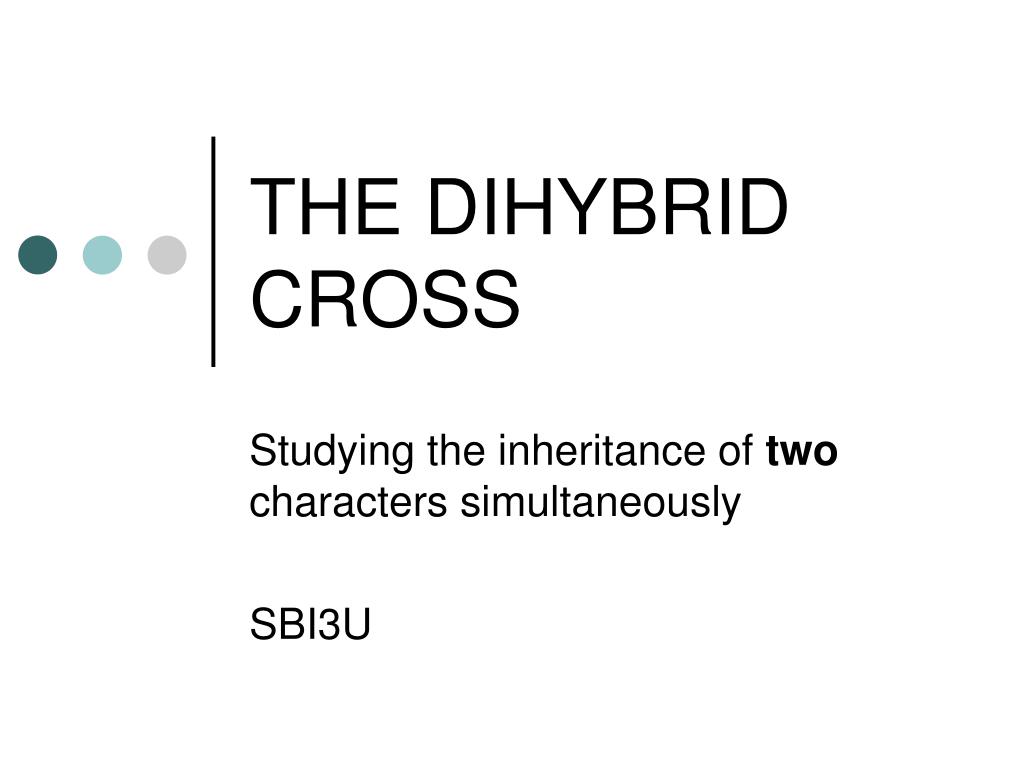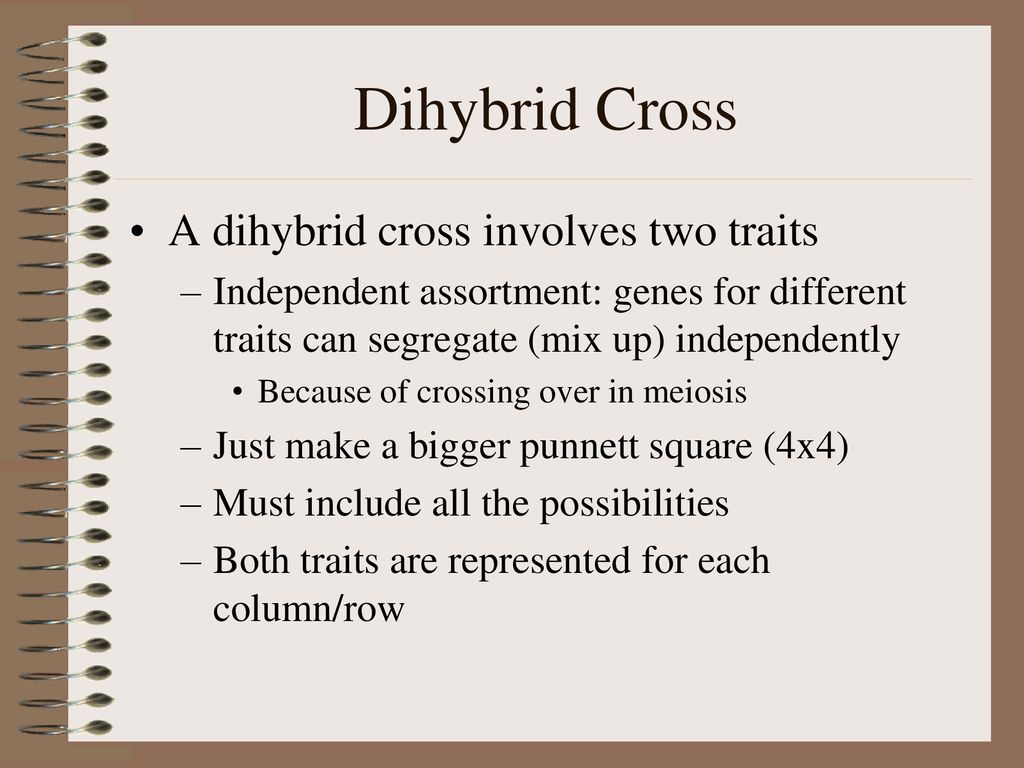A Dihybrid Cross Involves The Crossing Of Just One Trait. : Sbi3u : A dihybrid cross is the cross that involves parents that differ in two traits.
A Dihybrid Cross Involves The Crossing Of Just One Trait. : Sbi3u : A dihybrid cross is the cross that involves parents that differ in two traits.. An organism of genotype aabb can make gametes of all the following kinds except 10. A dihybrid cross is the cross that involves parents that differ in two traits. A dihybrid cross is simply an expansions of a punnet square to the point where the square depicts the independent assortment and expressions of there are crosses that can expand even further to fit more traits in the cross. After he crossed peas with contrasting traits and found that the recessive trait resurfaced in the f 2 generation, mendel deduced that because of independent assortment and dominance, the 9:3:3:1 dihybrid phenotypic ratio can be collapsed into two 3:1 ratios, characteristic of any monohybrid cross. Its phenotypic ratio is 9:3:3:1, where 9 plants have all dominant characteristics and 1 plant has all recessive characteristic.
A) 1/16 in this case, it will express the dominant trait in both cases. We explain dihybrid cross with video tutorials and quizzes, using our many ways(tm) approach from multiple teachers. • calculation of the predicted genotypic and phenotypic autosomal genes. If aabb is crossed with aabb, what proportion of the offspring will be dominant for the 'a/a' trait and recessive for the 'b/b' trait (i.e. Your instructor will review with you the basics for working genetics problems.

Recessive in the gene with alleles a and a from the cross.
The following figure explains the process of dihybrid crossing. If the inheritance of seed color was truly independent of seed shape, then when the modified ratios in the progeny of a dihybrid cross can therefore reveal useful information about the genes involved. When crossing an organism that is homozygous recessive for a single trait with a heterozygote, what is the. A dihybrid cross involves a study of inheritance patterns for organisms differing in two traits. A dihybrid cross is the cross that involves parents that differ in two traits. According to mendel's second law, the law of independent assortment , the inheritance of one trait will not affect the inheritance of another, meaning that alleles of each gene separate independently during gamete formation. A) 1/16 in this case, it will express the dominant trait in both cases. A dihybrid cross involves two traits. Mendel invented the dihybrid cross to determine if different traits of pea plants, such as flower color and seed shape, were inherited independently. Cross a male heterozygous for dimples and tongue rolling ability with a female of the same genotype. This one character is responsible to bring about the change in specie. Cross a flower that is heterozygous for both traits with another flower that is pink and tall. The inheritance of dihybrid traits can be calculated according example of a typical dihybrid cross.
Let's now examine a dihybrid cross that involves two traits. If the inheritance of seed color was truly independent of seed shape, then when the modified ratios in the progeny of a dihybrid cross can therefore reveal useful information about the genes involved. The square is set up below. E) a monohybrid cross results in a 9:3:3:1 ratio whereas a dihybrid cross gives a 3:1 ratio. Cross a male heterozygous for dimples and tongue rolling ability with a female of the same genotype.

This law states that alleles are transmitted to offspring a dihybrid cross deals with differences in two traits, while a monohybrid cross is centered around a difference in one trait.
A dihybrid cross is a cross that looks at how two different genes are passed on from a pair of if fur color and eye color did not sort independently or both parents were not identically heterozygous, then the ratio will not be 9:3:3:1. The inheritance of dihybrid traits can be calculated according example of a typical dihybrid cross. Similar to a punnet square, a dihybrid cross a dihybrid cross, however, tracks two traits, not just one. The cross of these particular dihybrids produces four phenotypic classes. A cyclops that is resistant to pesticides and has smooth antennae is crossed with one that is heterozygous for both traits. A) a monohybrid cross involves a single parent, whereas a dihybrid cross involves two parents. According to mendel's second law, the law of independent assortment , the inheritance of one trait will not affect the inheritance of another, meaning that alleles of each gene separate independently during gamete formation. A piece of dna that provides a set of instructions to a cell to make a certain protein. Thus, a dihybrid cross involves two pairs of genes. Its phenotypic ratio is 9:3:3:1, where 9 plants have all dominant characteristics and 1 plant has all recessive characteristic. This video will show how to set up and solve everyone's favorite 16 square punnett square. This is simply done by and expansion of the box and the number of gametes. A dihybrid cross involves two traits.
Transcribed image text from this question. Given four possible gamete types in each parent, there are 4 x 4 = 16 possible f2 combinations, and the probability of any particular dihybrid type is 1/4 x 1/4 = 1/16. Basically, the idea is in monohybrid cross only one characteristic is the phenotypic ratio becomes 3:1. Your instructor will review with you the basics for working genetics problems. Dihybrid crosses involve manipulation and analysis of two traits controlled by pairs of alleles at different loci.

In this cross the ratio would be as follows 3(tall purple):
This one character is responsible to bring about the change in specie. When crossing an organism that is homozygous recessive for a single trait with a heterozygote, what is the. Similar to a punnet square, a dihybrid cross a dihybrid cross, however, tracks two traits, not just one. Follow me and mark it as brainliest answer. Thus, a dihybrid cross involves two pairs of genes. A dihybrid cross is a cross that looks at how two different genes are passed on from a pair of if fur color and eye color did not sort independently or both parents were not identically heterozygous, then the ratio will not be 9:3:3:1. We compare two different characteristics in a dihybrid cross. Mendel invented the dihybrid cross to determine if different traits of pea plants, such as flower color and seed shape, were inherited independently. Dihybrid cross is a cross between two different lines/genes that differ in two observed traits. The law of segregation requires having two or more generations to describe. Particular chromosome when crossing over does not occur. A dihybrid cross describes a mating experiment between two organisms that are identically hybrid for two traits. Given four possible gamete types in each parent, there are 4 x 4 = 16 possible f2 combinations, and the probability of any particular dihybrid type is 1/4 x 1/4 = 1/16.
Komentar
Posting Komentar